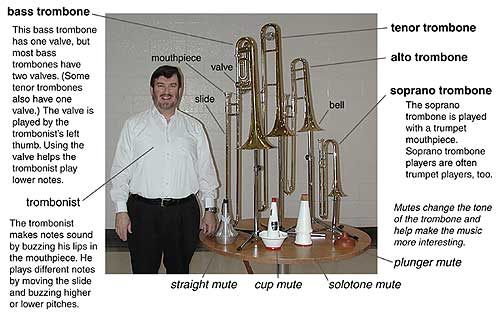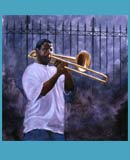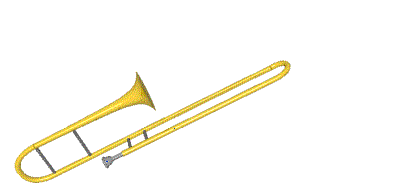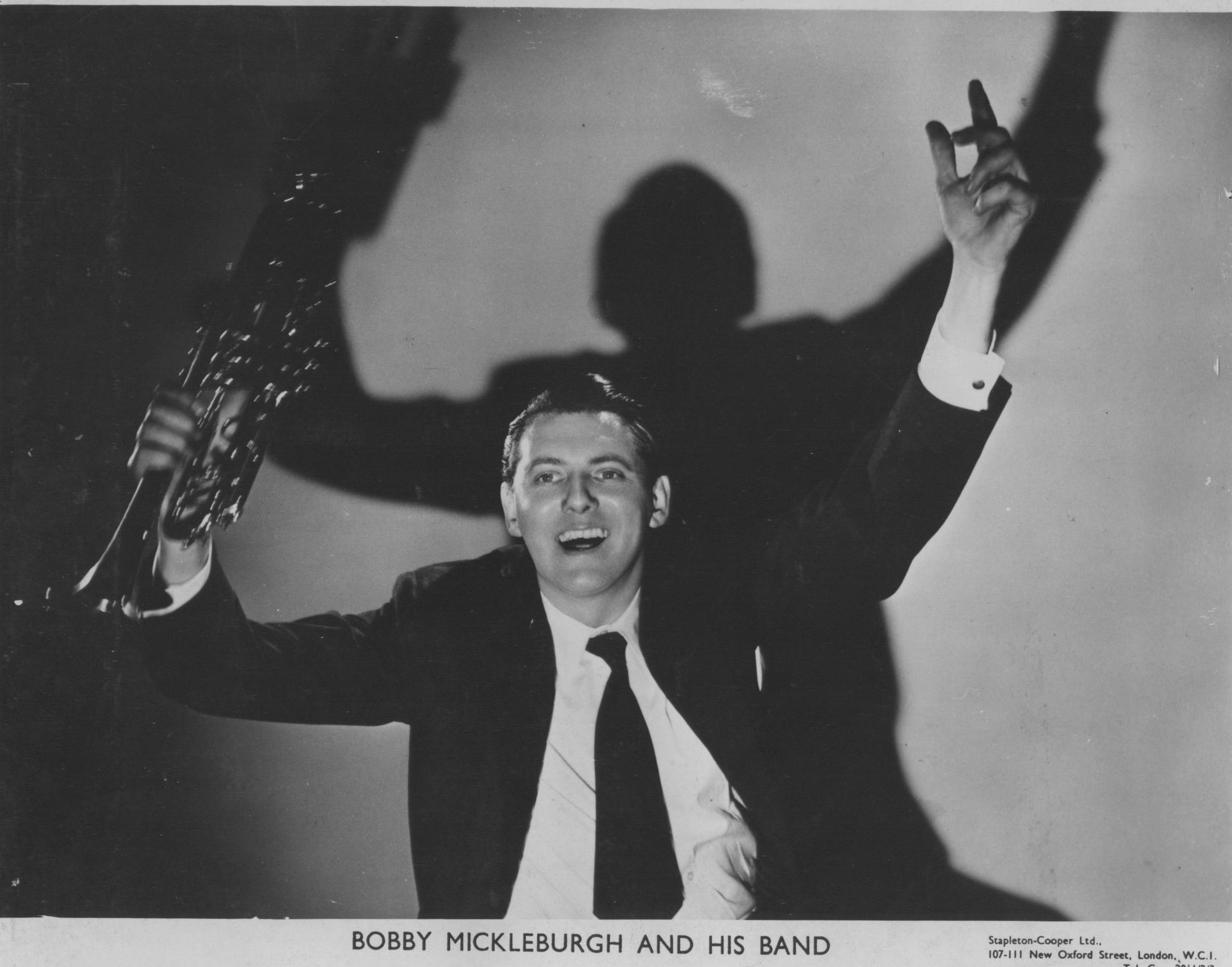CONCERT JAZZ
Events -
Chiltern Hundreds Area
|
CONCERT JAZZ
Events - |
|
|
|
 |
“This material by Dr. Glen Newton is adapted with permission from the trombone family information on the Roseville Big Band web site, http://www.rosevillebigband.org.”
The four most common members of the slide trombone family have the same names as the members of a vocal quartet: soprano, alto, tenor, and bass.
| The tenor trombone is by far the most popular. It's the one people refer to when they just say "trombone". Its fundamental pitch, the same as that of the euphonium, is an octave below the trumpet or cornet. However, unlike those instruments, the trombone uses a slide to help change pitches. The slides visible in the picture above are the outer slides; each outer slide surrounds an inner slide so that when the trombonist extends the outer slide, the instrument's length increases to allow the trombonist to play a different set of notes. | But what about the valve trombone? |
| This description of the tenor trombone refers to the slide trombone. Much of it (but not the part about moving the slide to change pitches) also applies to the valve trombone. In the United States, the valve trombone is primarily used as a convenient doubling instrument for euphonium or trumpet players, enabling them to play trombone music without mastering slide technique. |
Concert band music and jazz band music for the tenor trombone is written in bass clef, notated in concert pitch. (For example, if you play the trombone parts on a piano, the pitches will be the same.) Orchestral and solo music for the tenor trombone, as well as trombone choir music, is written in a combination of bass and tenor clefs. British brass band music includes two tenor trombone parts, and they are written in treble clef, notated a ninth above the actual sound.
The bass trombone is the next most popular member of the trombone family. Senior high school and college bands and orchestras often include a bass trombone. Over the years, the bass trombone has evolved from an instrument pitched in G, F, or E-flat (a musical third, fourth, or fifth below the tenor trombone) to the modern bass trombone, which is a large-bore tenor trombone with one or two valves to enable the player to reach the lower notes. The historical bass trombone either had a double slide or a single slide that was so long that it required the player to use an extension device to reach 6th and 7th positions.
The term "bore size" refers to the inner diameter of the inner slide. Bass trombones typically have a bore size of 0.560" or larger and a bell size of 9 to 10.5 inches, both of which help the player produce low notes without sounding tinny. Interestingly, the bass trombone in G historically had a much smaller bore and a bell smaller than that of some modern tenor trombones.
 Several factors influence the
tone of a brass instrument, among them the shape of the bore (the inside of the
tubing from the mouthpiece to the bell). The tenor trombone, bass trombone, and
euphonium all have the same fundamental pitch when no valves or slide are used,
and the trombones will sound very much alike because their bores are similar in
shape, with a large portion being cylindrical (a tube that is the same size
throughout), even though the bass trombone bore size is larger. In contrast, the
euphonium sounds different - some say "deeper" or "mellower" or "less edgy" -
primarily because a greater percentage of its bore is conical (a gently
expanding tube shape).
Several factors influence the
tone of a brass instrument, among them the shape of the bore (the inside of the
tubing from the mouthpiece to the bell). The tenor trombone, bass trombone, and
euphonium all have the same fundamental pitch when no valves or slide are used,
and the trombones will sound very much alike because their bores are similar in
shape, with a large portion being cylindrical (a tube that is the same size
throughout), even though the bass trombone bore size is larger. In contrast, the
euphonium sounds different - some say "deeper" or "mellower" or "less edgy" -
primarily because a greater percentage of its bore is conical (a gently
expanding tube shape).
Bass trombone parts are always written in bass clef in concert pitch.
Tenor and bass trombones are manufactured with several different valve configurations:
Tenor trombone with no valve (shown in the picture) - generally small (e.g., 0.490") to medium (e.g., 0.542) bore
Tenor trombone with one valve - generally medium bore (e.g., 0.525" to 0.542"); pressing the valve with the left-hand thumb increases the length of the air column and thus lowers the pitch a perfect fourth. If you hear someone refer to a "trigger trombone", this is what he means; the valve is also known as a trigger. Some manufacturers offer a convertible tenor trombone, from which the valve section may be removed to lighten the instrument when the valve isn't needed.
Bass trombone with one valve (shown in the picture above); the valve has the same function as on the tenor trombone, but the bass trombone player will sometimes extend the tuning slide of the valve section so that pressing the valve will lower the pitch an extra half step or more beyond the perfect fourth. This helps the bass trombonist with only one valve play a solid low C and minimizes the amount of "lipping down" that he or she must do to reach a low B below the bass staff.
Bass trombones with two valves, the second "dependent" on the first. The first valve, played with the thumb, lowers the pitch a perfect fourth. The second valve may be controlled with another thumb lever or with a lever for the left hand index finger. Pressing them both together will typically lower the pitch a perfect fifth or minor sixth, depending on how far out the player pulls the tuning slide for the second valve section, but other configurations are available. With two valves, a solid low B is within easy reach, so there is no need for the player to extend the first valve's tuning slide.
Bass trombones with two "independent" valves (shown in the picture below). As in the "dependent" case, the first valve will lower the pitch a perfect fourth. The second valve, typically played by the left hand index finger, can be used even if the first valve isn't, hence the two valves are independent of one another. Bass trombonists often tune the second valve section so that pressing the valve alone lowers the pitch a major third. Then when both valves are used together, the pitch is lowered by a minor sixth. Other popular second valve tunings lower the pitch by a minor third and a minor sixth.
The valves on a slide trombone are rotary valves. In contrast, the valves on a tenor valve trombone are piston valves. One special model, the Superbone by Holton, has both a slide section and a valve section; the player's right hand manipulates the slide, and the left hand plays the valves. Maynard Ferguson was the first great artist to play the Superbone.
Typical jazz charts, such as those played by the Roseville Big Band, have four trombone parts. The first three are always tenor trombone parts written for instruments without a valve section, and the fourth is most often written for bass trombone, with some alternate notes that don't require a valve section in case the player doesn't have the equipment for the low notes.
Tenor and bass trombone mouthpieces are manufactured with two different shank sizes. Tenor trombones with a small or medium bore use a tenor trombone shank, the smaller of the two. Bass trombones and large-bore tenor trombones use mouthpieces with a bass trombone shank, which is larger and aids in the production of a full sound on medium and low notes. Within each shank size, there is a nearly limitless variety of cup depths, backbores, rims, and outer shapes to suit the player's needs and tastes. In general, players who need to reach very high notes will choose a mouthpiece with a shallow cup and small rim diameter; the opposite is true of those who must play very low notes.
The modern alto trombone is pitched a perfect fourth higher than the tenor trombone. It has very limited use, compared with the tenor and bass trombone, but it is used in the orchestra, where many composers, particularly Beethoven and his contemporaries, created the first trombone parts to be played on the alto trombone. The alto trombone also has a role in the Moravian trombone choir (where its traditional pitch is F more often than E-flat) and in the modern trombone choir. In addition, there is a large solo repertoire for alto trombone. To help alto trombone players cope with the solo literature (and cover both alto and tenor trombone parts without having to carry a second instrument), some makers offer an alto trombone with a valve section in which pressing the valve lowers the pitch a perfect fourth.
The alto trombone mouthpiece shank is the same as that of the tenor trombone. Players who double on alto and tenor trombones (which is virtually 100% of all alto trombone players) often choose alto and tenor trombone mouthpieces with matching rims but differing cups and backbores.
The soprano trombone is pitched an octave above the tenor trombone. Its uses are even more limited than those of the alto trombone, principally confined to the trombone choir.
The soprano trombone is played with a trumpet mouthpiece. Because adapting to the mouthpiece is a significant part of learning to be a brass player, a significant percentage of the soprano trombone players in trombone choirs are trumpeters who have learned to deal with the slide, rather than trombonists who have learned to cope with the smaller mouthpiece. Furthermore, music for soprano trombone is usually notated the same as trumpet music, in treble clef, written one whole step above its sounding pitch. This has a practical value for composers who write for trombone choir, because if no soprano trombonist can be found, the part can be immediately played on trumpet.
|
|
Like the bass trombone, the contrabass trombone has had a variety of pitches and configurations throughout its history, reflecting the efforts of the players and makers to achieve a reasonable compromise between tone and convenience. The contrabass trombone is called for in some trombone choir and orchestral music, such as the operas of Wagner, and depending on the demands of the music (and equipment availability), the performer will typically use either a large-bore trombone in F with two valves or an instrument pitched an octave below the tenor trombone, in BB-flat, having a double slide. Alternatively, especially in the orchestra pit where space is at a premium, the player may use a valve contrabass trombone in a vertical configuration, in which the lower part of the instrument rests on the floor. Contrabass trombones have also been made in E-flat and CC. In this picture, Ken Leginchin, at the right, holds his Mirafone BB-flat single-rotor contrabass trombone and Don Dresser, at the left, holds his Olds double-rotor bass trombone. This contrabass trombone has a mouthpiece receiver that fits a tuba mouthpiece, and the mouthpiece pictured was made for a small tuba. |
 Adrian
Fry a regular dep with many bands,
but notably
Acker Bilk and his Paramount Jazz Band, the
Alan Barnes Octet,
Andy Dickens Band, Keith Nichols' Blue Devils Orchestra, the Ken McCarthy
Septet and the
Ray Gelato Giants. Also a member of the Don Weller Electric Octet
which can be seen occasionally at various UK jazz festivals. Big band -
The award-winning
Back to Basie can often be heard with Matt Ford recreating the Sinatra/Basie
collaboration of the 1960s. As well as being a member of the trombone section
Ade is also the band's chief transcriber/arranger. A regular member of the
big bands of Don Weller,
Michael Garrick and
Stan Tracey, and lead trombonist with the rarely heard
ED/GE and Johnny Keating Orchestra. I'm also a member of the fabulous
contemporary big band the London Jazz Orchestra. Throughout the Autumn of
2006 toured with the
Tony Hadley Big Band. In 2005 and toured Spain and France with
Gillespiana and
Lew Soloff, and can occasionally be seen with this and one of
Pete Long's other bands 9.20 Deluxe. Occasional dep with the
Bert Kaempfert Orchestra,
Pete Cater Big Band and Willie Garnett Big Band.
Adrian
Fry a regular dep with many bands,
but notably
Acker Bilk and his Paramount Jazz Band, the
Alan Barnes Octet,
Andy Dickens Band, Keith Nichols' Blue Devils Orchestra, the Ken McCarthy
Septet and the
Ray Gelato Giants. Also a member of the Don Weller Electric Octet
which can be seen occasionally at various UK jazz festivals. Big band -
The award-winning
Back to Basie can often be heard with Matt Ford recreating the Sinatra/Basie
collaboration of the 1960s. As well as being a member of the trombone section
Ade is also the band's chief transcriber/arranger. A regular member of the
big bands of Don Weller,
Michael Garrick and
Stan Tracey, and lead trombonist with the rarely heard
ED/GE and Johnny Keating Orchestra. I'm also a member of the fabulous
contemporary big band the London Jazz Orchestra. Throughout the Autumn of
2006 toured with the
Tony Hadley Big Band. In 2005 and toured Spain and France with
Gillespiana and
Lew Soloff, and can occasionally be seen with this and one of
Pete Long's other bands 9.20 Deluxe. Occasional dep with the
Bert Kaempfert Orchestra,
Pete Cater Big Band and Willie Garnett Big Band.
Amos Miller - Trombones
Amos Miller studied the violin from an early age and took up the trombone at nine with John Berry proceeded through Oxford University and the Royal Academy of Music, learning with Eric Crees, Denis Wick and Ian Bousfield, and playing principal trombone for the National and European Youth Orchestras. Having gained the Dip.RAM, the Academy's highest award for performance, he completed the Jazz Course at the Banff Center for the Arts in Canada, under artists such as Jim Hall and Kenny Wheeler. On leaving the RAM he was awarded the coveted Meaker fellowship. He now combines the post of principal trombone with the Royal Ballet Sinfonia (to which he was appointed in 2003) with a busy freelance career in which he has worked as guest principal trombone with all the major London orchestras, the City of Birmingham Symphony Orchestra and the BBC National Orchestra of Wales, as well as the English Chamber Orchestra, Academy of St. Martin's, the London Sinfonietta and the Orchestra of the Age of Enlightenment. Abroad, he has worked with Ensemble Modern of Frankfurt and is guest principal with the Orquesta Ciudad de Granada in Spain. Amos also has many educational commitments: in addition to his positions as trombone teacher for the Royal Air Force and St. Paul's School, he works regularly for the outreach departments of the English Chamber and London Symphony orchestras, and Birmingham Royal Ballet. He is the co-author of "Time Pieces for Trombone" for the Associated Board, and is the author of "A New Tune a Day for Trombone", published by the Boston Music company. He is a trustee of the Clarence Myerscough and Christopher Horn charitable trusts and is an Associate of the Royal Academy of Music. He has played on a number of film recordings and for Onxy Brass.
In the field of education he was awarded a prestigious Meaker fellowship at the RAM, where he coached ensembles and sectionals, he teaches trombone for the RAF music services at Uxbridge, and at St. Paul's School. He has also coached the brass of the London Schools Symphony Orchestra and the Lancashire Schools Training Orchestra.
 Originally
from Berwick-Upon-Tweed, Gordon Campbell started playing the trombone in
Northumberland at the tender age of 12.
Originally
from Berwick-Upon-Tweed, Gordon Campbell started playing the trombone in
Northumberland at the tender age of 12.
Gordon Campbell is regarded as one of this country’s leading trombone players he
is currently lead trombone in the BBC Big Band a position he has held since
1984. His varied career has encompassed jazz, classical, musical theatre, film
and pop and he has worked with many of the worlds leading performers including,
Ella Fitzgerald, Sarah Vaughan, Barbara Streisand, Tony Bennett, Ray Charles and
Robbie Williams to name but a few.
He also plays regularly with the Robert Farnon Orchestra and the Laurie Johnson
London Big Band.

http://www.trombonefestival.net/
Robin Eubanks - Trombonist - Check out his Blues for Jimi
Martin Gladdish - Superb
Reader and Master of the Slide and plays for
The Jazz Warriors -
young professionals from the stable of the Pendulum Jazz Orchestra.
Featuring Peter Billington (piano/guitar) Simon Allen (saxes), Martin Gladdish
(trombone), Tom Mason (bass) and Mike Bradley (drums), The Jazz Warriors
produce a creative arc of sensitivity, energy and drive.
 Mark
Nightingale
Mark
NightingaleMark Nightingale started playing trombone at the age of nine. At 15 he won the Don Lusher Award in the BBC Rehearsal Band Competition and became lead trombone with the National Youth Jazz Orchestra a year later. During six years with NYJO he also graduated from Trinity College of Music and formed the 5-trombone group Bonestructure.
He has appeared at international festivals alongside Carl Fontana, Jiggs Whigham, Urbie Green, Slide Hampton, Bart van Lier, Bert Boeren, and many others. Mark has been featured with artists as diverse as Frank Sinatra, Cleo Laine, London Brass, Royal Philharmonic Orchestra, Sting and Shakatak. He has penned many compositions and big band arrangements, plus several books of trombone studies.
Andy Wood - Trombone &
Euphonium
 Andy
is a freelance trombonist working mainly in London. He is the jazz trombone
soloist with the world-renown BBC Big Band, works with The Wright Stuff and has
recorded and performed with most of the top artists from the world of jazz, pop
and classical. He is a busy session musician and can be heard on many TV, radio
shows, jingles and TV specials and is a member of the Michael Parkinson House
Band with Laurie Holloway and the hit TV show 'Strictly Come Dancing', Children
In Need, The Royal Variety Performance, and has played Tenor and Bass Trombones
on many Hollywood movie soundtracks. He delivered a fascinating masterclass,
talking about everything from practice techniques to different styles of
playing. He really is a superb bone player. He has diverse musical tastes though
Jazz is his favourite. Artists such as
Pat Metheney,
Arturo Sandoval,
Ronny Jordan, Don Ellis,
Incognito and
Jaco Pastorius feature heavily in
his music collection.
Andy
is a freelance trombonist working mainly in London. He is the jazz trombone
soloist with the world-renown BBC Big Band, works with The Wright Stuff and has
recorded and performed with most of the top artists from the world of jazz, pop
and classical. He is a busy session musician and can be heard on many TV, radio
shows, jingles and TV specials and is a member of the Michael Parkinson House
Band with Laurie Holloway and the hit TV show 'Strictly Come Dancing', Children
In Need, The Royal Variety Performance, and has played Tenor and Bass Trombones
on many Hollywood movie soundtracks. He delivered a fascinating masterclass,
talking about everything from practice techniques to different styles of
playing. He really is a superb bone player. He has diverse musical tastes though
Jazz is his favourite. Artists such as
Pat Metheney,
Arturo Sandoval,
Ronny Jordan, Don Ellis,
Incognito and
Jaco Pastorius feature heavily in
his music collection.
http://www.lornamcdonald.co.uk/
 Bobby
Mickleburgh : trumpet player, trombone player, tuba player, band leader,
mouthpiece-maker -
Bobby
Mickleburgh : trumpet player, trombone player, tuba player, band leader,
mouthpiece-maker - Bobby Mickleburgh - ‘The General’ - Bobby and his Bobcats and also the Temperence Seven - jazz recording artist and old school British jazz great who represented the UK in the very first Nice International Jazz festival after world war 2. Louis Armstrong played with him in London in 1961 – with Dill Jones on piano – Bobby is 89 and still playing – you don’t get much more hip when mentioning a British jazz artist (i.e. when Louis turned to the other band members and stating to them: ‘he sounds just like my boy Jack ‘ (Louis referring to Jack Teagarden the world’s greatest trombone player and a member of Louis’ Allstars)
Send mail to
jazzmaster@jazzeddie.f2s.com
with questions or comments about the design only of this web site.
|